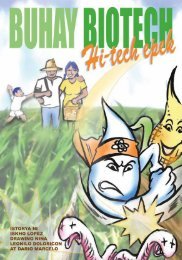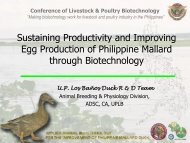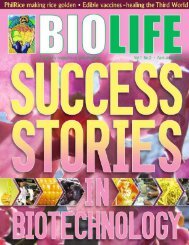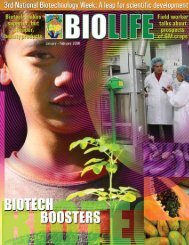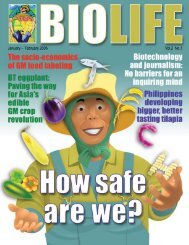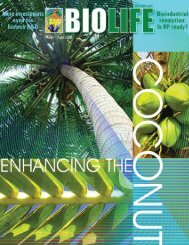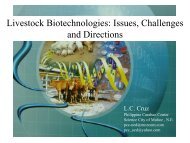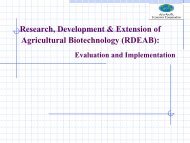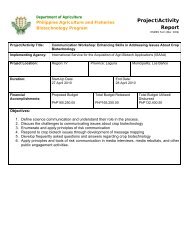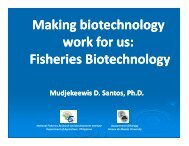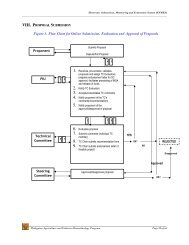Download PDF - SEARCA Biotechnology Information Center
Download PDF - SEARCA Biotechnology Information Center
Download PDF - SEARCA Biotechnology Information Center
Create successful ePaper yourself
Turn your PDF publications into a flip-book with our unique Google optimized e-Paper software.
January – March 2005 BIO LIFE<br />
7<br />
Senior Agriculturist Jane Bartolini isolates DNA from individual plant samples for purity testing.<br />
This will also give the government an opportunity to use advanced<br />
testing based on reliable and efficient molecular techniques<br />
for variety verification, pathogen identification in relation to seed<br />
health testing and seed quality control program, she says.<br />
The NSQCS is actually the agency that is mandated to continuously<br />
provide services such as seed certification, seed testing and<br />
training needed in assuring and maintaining the quality of seeds<br />
used to improve agricultural production in the country.<br />
Maribel Querijero, a senior agriculturist who is stationed at the<br />
biotech laboratory, says that as a member of the International Seed<br />
Testing Association, they have to cope with the challenges triggered<br />
by the globalization for the Philippines to regain competitiveness in<br />
the seed market.<br />
As government’s regulatory body, the NSQCS is tasked to assure<br />
planters a steady supply of high quality seeds and planting<br />
materials with distinctness, uniformity and stability.<br />
“If seed growers or seed companies want to prove their seed is<br />
not contaminated by any GM we can test. But since some producers<br />
are promoting GMOs, we can also prove that in testing their<br />
products,” says Querijero, who has been into seed testing since 1990<br />
when she joined the BPI after a brief stint with the International Rice<br />
Research Institute in Los Banos.<br />
With her experience in biotech products, Querijero says she can<br />
assure that GMOs that are being tested here do no create allergens,<br />
contrary to critics claim. “I’ve seen it. The genes that they<br />
insert in feed do not really harm humans,” she says.<br />
THE year 2002 was actually the time when the Corn MON810, or<br />
popularly known as Bt corn, was finally approved by government<br />
for propagation as well as direct use for food or feed and processing.<br />
It was widely acknowledged as a major breakthrough in the agriculture<br />
and science communities. It opened the country to the propagation<br />
of modern biotechnology. It also took the challenge needed<br />
to help ensure the success of government’s food security agenda.<br />
The Bacillus thuringiensis or Bt corn, is resistant to corn borer,<br />
an insect that destroys corn crops. Bt corn is produced by transferring<br />
bacterial genes to the corn to make it resistant to corn borer.<br />
The product was already commercially available in the United<br />
States, Canada, Japan, European Union, South Africa and Argentina<br />
but the BT corn still had to pass through the Department of<br />
Agriculture’s stringent—and rigid — evaluation process. The Bureau<br />
of Animal Industry (BAI) tapped 16 personnel for feed safety,<br />
the Bureau of Agriculture and Fisheries Product Standards (BFARS)<br />
and two technical experts from the Fertilizer and Pesticides Authority<br />
(FPA ) the safety in handling of BT corn in food and feed.<br />
Finally, experts concluded that Bt corn was safe to humans,<br />
animals, non-target organisms. It was also as nutritious as any ordinary<br />
corn, safer than chemical insecticides and very effective in controlling<br />
Asiatic corn borer.<br />
Despite its discovered wonders, it’s not surprising that cynics<br />
would simply find BT corn a killer. It has a smack of multinational<br />
control, tracing its roots to the US multinational giant Monsanto, which<br />
was a target of a worldwide campaign by anti-biotech activists.




